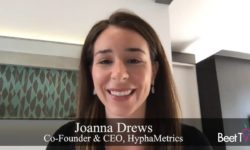LONDON – In the emerging world of addressable TV advertising, the dichotomy for buyers appears to be this – the technology makes buying TV cheaper than ever, yet channel fragmentation means doing so remains burdensome.
Addressability allows ad buyers to target ads at particular groups of viewers – sometimes even individual households – thanks to viewing platforms’ audience identifiers.
But Harry Harcus, the managing director of GroupM’s specialist advanced TV buying unit Finecast, says the many connected viewing devices and programming providers nevertheless makes for complexity.
Fragmented opportunity
In this video interview with Beet.TV editorial advisor Jon Watts, Harcus says: “The barrier to entry (to TV) is just lower than it used to be.
“In a year of the pandemic, we’ve seen small – often, direct-to-consumer brands – coming through with much lower budgets, still able to produce fantastic TV creative, but able to target an audience that’s very specific to them, whether that is demographically, geographically or around very specific behaviors and sections of the audience.”
Our Head of Engagement, @ClaxtonKristian spoke alongside @DLGroupMedia's Sam Taylor @Campaignmag #Media360 earlier this month demonstrating why addressable is the future of TV advertising. Here are 6 reasons https://t.co/2HQflo3N2a
— Finecast (@Finecast) October 8, 2020
“To reach them at the moment, the problem is it’s become a very fragmented ecosystem. You’d have to go to each (UK) broadcaster in turn to reach their on-demand audience and, by the way, not able to reach their linear audiences on an addressable basis yet.”
In Harcus’ native UK, Sky’s AdSmart technology powers addressable linear TV ads across its own distribution platform and has inked a deal with rival Virgin Media, while ITV and Channel 4 now sell targeted on-demand ads in their cross-platform viewing apps.
“You’ve got the new CTV suppliers coming in as well,” Harcus adds. “So in terms of where the audience are and the content that they’re viewing, they’re pretty scattered.”
Direct to TV
New-look TV’s ability to serve a new generation of brands has been documented, for example, in research by VAB.
Finecast’s Harcus says such digital brands have, online, enjoyed the ability to do fine-grained audience targeting and measurement, but have not been called to TV due to the absence of such attributes.
Connected TV changes that, however, and is now beckoning a new generation of brands that want to build their names using digital-style targeting on the main screen in the house.
“TV is probably the most loved advertising medium and one that most people can relate most easily to,” Harcus says.
Research exercise
Finecast is a major buyer of connected TV advertising. That also makes it a major partner for brands attempting to pick their way through both the fragmentation and the opportunity in front of them.
Finecast has recently learned a lot more about both thanks to research carried out by Dipsticks Research Group (DRG) and University College London (UCL).
Harcus says the research has an important takeaway – there is a difference between relevant targeted TV ads and personalized ones.
“The good news is that what the research did show – through surveys, through ethnography studies and through neuroscience – is the relevance of advertising messages does make a difference,” he explains. “It leads to higher engagement and ultimately greater effectiveness of advertising.”
We launched the results from our #ThinkingInsidetheBox research last week with DRG and @ucl.
Take a look at how TV advertising has changed and how new mechanisms could help brands to advertise on TV effectively https://t.co/a41Pt2uKu1#addressabletv #BVOD #AVOD #SVOD #lineartv pic.twitter.com/LCLoAsB8Uc
— Finecast (@Finecast) October 5, 2020














































